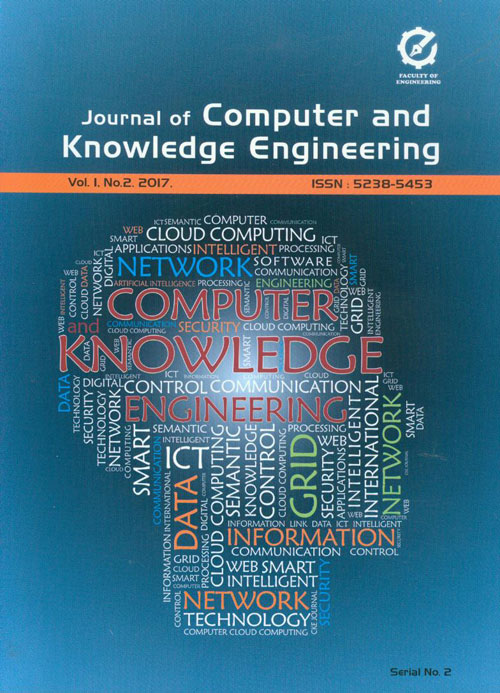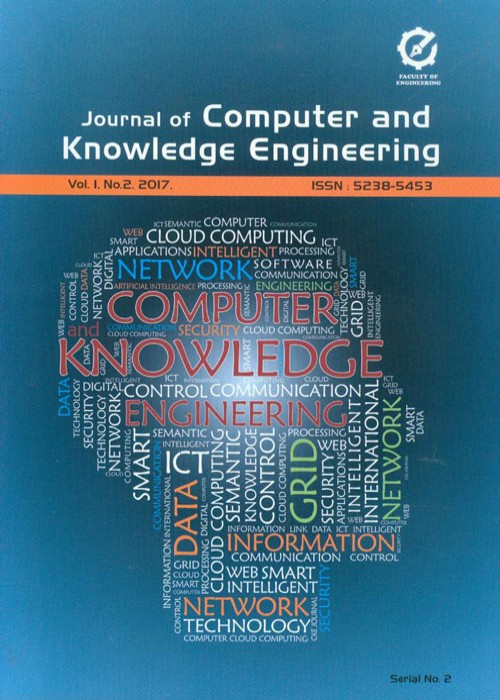فهرست مطالب

Journal of Computer and Knowledge Engineering
Volume:1 Issue: 2, Summer-Autumn 2018
- تاریخ انتشار: 1396/09/30
- تعداد عناوین: 6
-
-
Pages 1-12Placement of virtual sensors in servers of cloud environment is one of the most important issues in resource management of sensor-cloud networks. Virtual sensors allocate resources of cloud servers to themselves, run different applications and use equivalent physical sensors. Selecting an appropriate method for placement of virtual sensors on cloud servers has a significant impact on resource management and energy consumption. Also, because of the real-time requirements of sensor-cloud networks, traffic-aware placement is necessary to minimize delay in a network and respond to user requests in the shortest possible time. A new method for traffic-aware placement and migration of virtual sensors in sensor-cloud networks is proposed using the unique characteristics of sensor-cloud networks such as grouping virtual sensors and sharing them among different applications. This approach tries to meet the needs of users and the quality of service expected by the applications. Also, the resources of cloud servers are managed properly in this approach. The results of simulation show an optimization in energy consumption and also a reduction in traffic costs and reduction in service level agreement violation.Keywords: Sensor-cloud networks, virtual sensors, resource management, migration, energy consumption, traffic
-
Pages 13-20Target tracking is estimating the state of moving targets using noisy measurements obtained at a single observation point or node. Particle filters or sequential Monte Carlo methods use a set of weighted state samples, called particles, to approximate the posterior probability distribution in a Bayesian setup. During the past few years, Particle Filters have become very popular because of their ability to process observations represented by nonlinear state-space models where the noise of the model can be non-Gaussian. There are many Particle Filter methods, and almost all of them are based on three operations: particle propagation, weight computation, and resampling. One of the main limitations of the previously proposed schemes is that their implementation in a wireless sensor network demands prohibitive communication capability since they assume that all the sensor observations are available to every processing node in the weight update step. In this paper, we use a machine learning technique called support vector machine to overcome this drawback and improve the energy consumption of sensors. Support Vector Machine (SVM) is a classifier which attempts to find a hyperplane that divides two classes with the largest margin. Given labeled training data, SVM outputs an optimal hyperplane which categorizes new examples. The training examples that are closest to the hyperplane are called support vectors. Using our approach, we could compress sensor observations and only support vectors will be communicated between neighbor sensors which lead to cost reduction in communication. We use LIBSVM library in our work and use MATLAB software to plot the results and compare the proposed protocol with CPF and DPF algorithms. Simulation results show significant reduction in the amount of data transmission over the network.Keywords: Distributed Particle Filter, Support Vector Machines, Target Tracking, Wireless Sensor Networks
-
Pages 21-26This study proposes a novel routing algorithm using Q-learning. Q-learning is a machine learning (artificial intelligence) algorithm using the reinforcement learning policy which can be used to solve problems for which there are different ways to reach their goal. The proposed algorithm, the Modified Q-learning routing algorithm (MQRA), has eliminated the episodes of Q-learning required to gradually learn in different stages and this has made it a rapid routing algorithm. MQRA can be used in various types of networks. This study uses MQRA in mobile ad-hoc networks, its generalization to fisheye state routing (FSR) (a routing algorithm) and its performance results are compared with the standard FSR. Experimental results confirm the applicability and potential of the proposed algorithm.Keywords: Routing Algorithm, Mobile ad-hoc Networks, FSR Protocol, Reinforcement Learning, Routing in MANETs
-
Pages 27-32This study proposes a novel routing algorithm using Q-learning. Q-learning is a machine learning (artificial intelligence) algorithm using the reinforcement learning policy which can be used to solve problems for which there are different ways to reach their goal. The proposed algorithm, the Modified Q-learning routing algorithm (MQRA), has eliminated the episodes of Q-learning required to gradually learn in different stages and this has made it a rapid routing algorithm. MQRA can be used in various types of networks. This study uses MQRA in mobile ad-hoc networks, its generalization to fisheye state routing (FSR) (a routing algorithm) and its performance results are compared with the standard FSR. Experimental results confirm the applicability and potential of the proposed algorithm.Keywords: Routing Algorithm, Mobile ad-hoc Networks, FSR Protocol, Reinforcement Learning, Routing in MANETs
-
Pages 33-46This research with attention to the establishment of trust in WSNs and with the goal of increment in energy supply and growth in malicious node detection accuracy by using of improved sliding window, is saving energy by using computation of the previous periods. Also, this research calculates the trust in aspect of transferring information, based on subjective logic model and incremented the detection rate of malicious node by proposing two algorithms for identifying these nodes. Then, this method increases the speed of routing. The results of simulation of STAR compared to EDTM (Jiang, et al., 2015) shows 11.99% increment in the residual energy of network and growth of 1.52% in detecting the accuracy of malicious nodes.Keywords: Trust, Wireless Sensor Network, Subjective Logic Model, Sliding Window, Confidence, Routing
-
Pages 47-54The goal of many tasks in the realm of sequence processing is to map a sequence of input data to a sequence of output labels. Long short-term memory (LSTM), a type of recurrent neural network (RNN), equipped with connectionist temporal classification (CTC) has been proved to be one of the most suitable tools for such tasks. With the aid of CTC, the existence of per-frame labeled sequences are no longer necessary and it suffices to only knowing the sequence of labels. However, in CTC, only a single state is assigned to each label and consequently, LSTM would not learn the intra-label relationships. In this paper, we propose to remedy this weakness by increasing the number of states assigned to each label and actively modeling such intra-label transitions. On the other hand, the output of a CTC network usually corresponds to the set of all possible labels along with a blank. One of the uses of blank is in the recognition of multiple consecutive identical labels. Assigning more than one state to each label, we can also decode consecutive identical labels without resorting to the blank. We investigated the effect of increasing the number of sub-labels with/without blank on the recognition rate of the system. We performed experiments on two printed and handwritten Arabic datasets. Our experiments showed that while on simple tasks a model without blank may converge faster, on real-world complex datasets use of blank significantly improves the results.Keywords: Connectionist Temporal Classification, Handwriting Recognition, Recurrent Neural Networks, Multidimensional Long Short Term Memory, Blank


